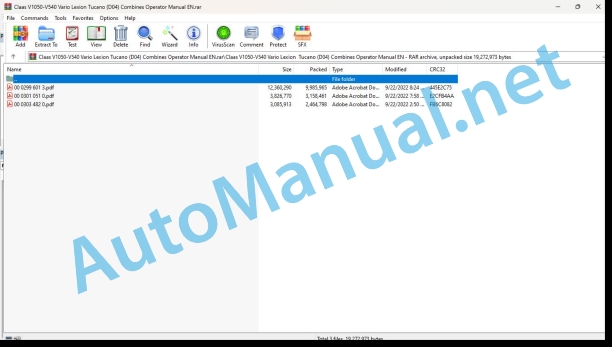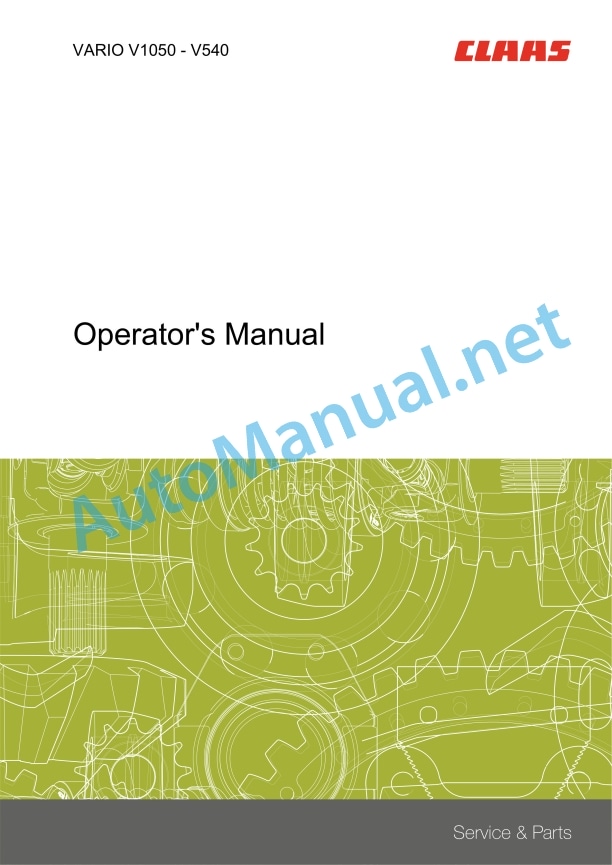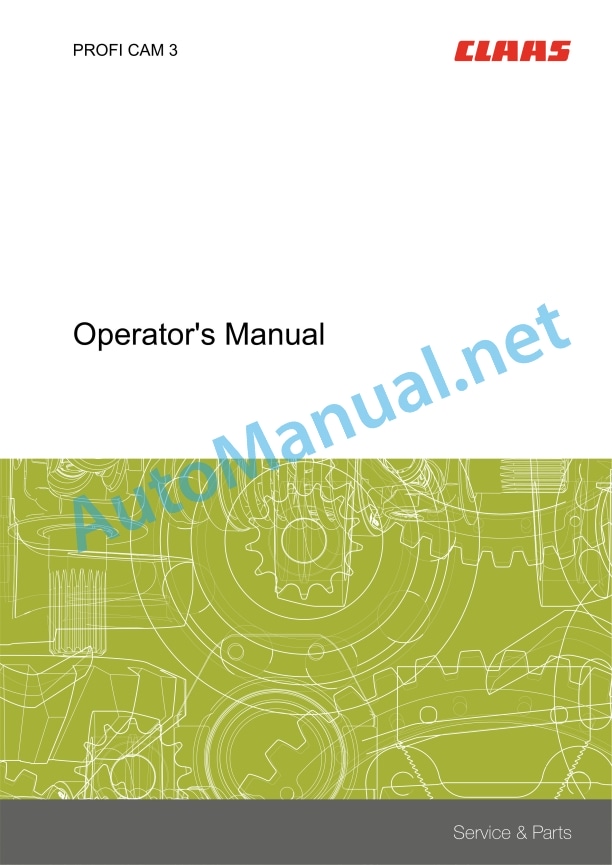Claas V1050-V540 Vario Lexion Tucano (D04) Combines Operator Manual EN
$50.00
- Model: V1050-V540 Vario Lexion Tucano (D04) Combines
- Type Of Manual: Operator Manual
- Language: EN
- Format: PDF(s)
- Size: 14.9 MB
File List:
00 0299 601 3.pdf
00 0301 051 0.pdf
00 0303 482 0.pdf
00 0299 601 3.pdf:
VARIO V1050 – V540
Table of contents
1 To this Operator’s Manual
1.1 Notes on the manual
1.1.1 General instructions
1.1.2 Validity of this manual
1.1.3 Handling of manual
1.1.4 Symbols and notes
1.1.5 Machine equipment
1.1.6 Technical specifications
2 Safety
2.1 Safety rules
2.1.1 Observe when working on the machine
2.1.2 General instructions
2.1.3 Important!
2.1.4 Qualification of drivers and maintenance personnel
2.1.5 Intended use
2.1.6 Reasonably foreseeable misuse
2.1.7 General safety and accident prevention regulations
2.2 Safety instructions for use
2.2.1 Precautionary measures
2.2.2 Compressed air and water
2.2.3 Danger of injury from hydraulic liquid
2.2.4 Burn prevention
2.2.5 Oils
2.2.6 Fire prevention and explosion prevention
2.2.7 Lines, tubes and hoses
2.2.8 Before every start-up
2.2.9 Putting the machine into operation
2.2.10 Road travel
2.2.11 Parking
2.3 Safety instructions in this manual
2.3.1 Marking of warning and hazard notes
2.4 Safety decals on the machine
2.4.1 General information on safety decals
2.4.2 Position of safety decals
2.5 Safety devices
2.5.1 Applying the feed rake conveyor safety lock
2.5.2 Releasing the feed rake conveyor safety lock
2.5.3 Fitting the reel safety lock
2.5.4 Setting out the reel safety locks
2.5.5 Fitting the finger bar safety device
3 Machine description
3.1 Overview and method of operation
3.1.1 Overview of machine
3.1.2 Function principle of machine with grain equipment
3.1.3 Function principle of machine with rape cutting equipment*
3.2 Safety devices
3.2.1 Function principle of slip clutch
3.3 Optional machine equipment
3.3.1 Optional equipment
3.3.2 Speed reduction
3.3.3 Rice mower head
3.4 Identification plates and identification number
3.4.1 Position of identification plates
3.4.2 Explanation of machine identification plate
3.5 Information on the machine
3.5.1 Decal
4 Operating and control elements
4.1 Cab / Operator’s platform
4.1.1 Control panel
4.2 Crop feeding
4.2.1 Table adjustment
5 Technical specifications
5.1 V1050 / V900 / V750 / V660 / V600 / V540 – Type 716
5.1.1 Compatible machines
5.1.2 Dimensions
5.1.3 Weights
5.1.4 Cutting widths
5.1.5 Speeds
5.1.6 Crop pick-up
5.1.7 Feeder
5.2 Operating utilities
5.2.1 Lubricants
5.2.2 Hydraulic oil
6 Machine preparation
6.1 Shutting down and securing the machine
6.1.1 Stop and secure the machine
6.2 Prior to operation
6.2.1 Carry out prior to initial commissioning
6.2.2 Carry out prior to every operation
6.3 Loading the front attachment
6.3.1 Loading and lashing down the front attachment
6.4 Mounting front attachment
6.4.1 Installing the front attachment
6.4.2 Preparing the locking mechanism
6.4.3 Installing the locking pawl
6.4.4 Suspending the front attachment
6.4.5 Locking the front attachment
6.4.6 Installing the universal drive shaft
Checking the chain length
6.4.7 Mounting the multi-coupler
6.4.8 Removing the stands
6.5 Removing front attachment
6.5.1 Removing the front attachment
6.5.2 Adjusting the table to transport position
6.5.3 Fitting the stands
6.5.4 Removing the multi-coupler
6.5.5 Removing the universal drive shaft
6.5.6 Unlocking the front attachment
6.5.7 Unhinging the front attachment
6.6 Electrical / Electronic equipment
6.6.1 Removing the AUTO CONTOUR* sensor band transport safety equipment
6.6.2 Installing the left rape cutter* switch
6.7 Crop feeding
6.7.1 Removing the reel transport safety equipment
6.7.2 Removing the reel cylinder transport safety equipment
6.8 Feeder unit
6.8.1 Adapting the scraper profiles to the feed rake conveyor
Selecting the scraper profiles
Adjusting the scraper profiles
7 Operation
7.1 Driving the machine
7.1.1 Preparing road travel
7.1.2 Preparing for fieldwork
7.2 Fieldwork
7.2.1 Prior to fieldwork
7.2.2 Checking the crop pick-up
7.3 Rape harvest
7.3.1 Installing the rape cutting equipment
7.3.2 Installing the rape cutting equipment belt
7.3.3 Fitting the rape cutting equipment plates
7.3.4 Installing the rape cutter
7.3.5 Connecting the hydraulic system
Right side of front attachment
Left side of front attachment
7.3.6 Connecting the power supply
7.3.7 Fitting the deflector curtain
7.3.8 Converting the LASER PILOT* to rape harvesting
7.3.9 Putting the hydraulic pump into operation
Putting the pump into operation
7.4 Grain harvest
7.4.1 Fitting the grain equipment
7.4.2 Putting the hydraulic pump out of operation
7.4.3 Converting the LASER PILOT* to grain harvest
7.4.4 Removing the deflector curtain
7.4.5 Disconnecting the power supply
7.4.6 Disconnecting the hydraulic system
Right side of front attachment
Left side of front attachment
7.4.7 Removing the rape cutter
7.4.8 Removing the rape cutting equipment plates
7.4.9 Installing the grain harvest equipment belt
7.5 Steering
7.5.1 Folding out the LASER PILOT*
7.5.2 Folding out the LASER PILOT*
7.5.3 Folding in the LASER PILOT*
7.6 Crop feeding
7.6.1 Fitting the long crop divider
7.6.2 Removing the long crop divider
7.6.3 Adjusting the long crop divider
7.6.4 Folding out the long crop divider
7.6.5 Folding in the long crop divider
7.6.6 Installing the outer deflector*
7.6.7 Removing the outer deflector*
7.6.8 Installing the short crop divider
7.6.9 Removing the short crop divider
7.6.10 Adjusting the short crop divider
7.6.11 Folding out the short crop divider
7.6.12 Folding in the short crop divider
7.6.13 Installing the special crop divider
7.6.14 Removing the special crop divider
7.6.15 Folding out the special crop divider
7.6.16 Folding in the special crop divider
7.6.17 Adjusting the table length from the machine
7.6.18 Adjusting the table length from the front attachment
7.6.19 Adjusting the reel tines
7.7 Feeder unit
7.7.1 Adjusting the scraper profile of the intake auger
7.7.2 Adjusting the position of the intake auger
Adjusting the centre bearing
7.7.3 Adjusting the intake auger fingers
7.7.4 Removing the auger baffle plate extension
7.7.5 Installing the baffle plate extension
7.7.6 Adjusting the intake auger speed
Reversing the sprocket
Relocating the sprocket
7.8 Mower unit
7.8.1 Installing crop lifters
7.8.2 Removing the crop lifter
7.8.3 Engaging the rape cutter
7.9 Ground guidance
7.9.1 Adjusting the skids
8 Faults and remedies
8.1 Overview of faults
8.1.1 Front attachment
8.2 Hydraulic system
8.2.1 Bleeding the reel hydraulic cylinders
8.2.2 Bleeding the table adjustment hydraulic cylinder
8.3 Electrical / Electronic equipment
8.3.1 Adjusting the table adjustment switch
8.3.2 Adjusting the reel speed sensor
8.4 Crop feeding
8.4.1 Adjusting the basic reel height
Adjusting the spring
8.4.2 Replacing the reel tines
8.4.3 Replacing the reel rivet nut
8.5 Feeder unit
8.5.1 Replacing intake auger fingers
8.6 Mower unit
8.6.1 Replacing the riveted knife section
8.6.2 Changing the bolt-on knife section
8.6.3 Replacing the double fingers
8.7 Ground guidance
8.7.1 Adjusting the AUTO CONTOUR* potentiometer
Left side of front attachment
Right side of front attachment
9 Maintenance
9.1 Maintenance intervals
9.1.1 Handling of maintenance intervals
9.1.2 Before the harvest
9.1.3 After the first 100 operating hours
9.1.4 Every 10 operating hours or daily
9.1.5 Every 100 operating hours
9.1.6 Every 250 operating hours
9.1.7 Every 500 operating hours or annually
9.1.8 After the harvest
9.2 Maintenance operations in general
9.2.1 Preserving the front attachment
9.2.2 Fixing material
9.3 Gearbox / Clutch / Universal drive shaft
9.3.1 Checking the gearbox oil level
9.3.2 Draining the gearbox oil
9.3.3 Topping up gearbox oil
9.4 Drives
9.4.1 Drive diagram
9.4.2 Removing belt (R01)
9.4.3 Installing belt (R01)
9.4.4 Adjusting belt (R01)
9.4.5 Removing chain (K01)
9.4.6 Installing chain (K01)
9.4.7 Adjusting chain (K01)
9.4.8 Removing chain (K02)
9.4.9 Installing chain (K02)
9.4.10 Adjusting chain (K02)
9.4.11 Checking the chain tension
9.5 Hydraulic system
9.5.1 Checking the oil level in the hydraulic tank
9.5.2 Draining oil from the hydraulic tank
9.5.3 Changing the return flow filter on the hydraulic tank
9.5.4 Topping up oil in the hydraulic tank
9.5.5 Check the hydraulic hoses
9.6 Steering
9.6.1 Adjusting the LASER PILOT* bracket
9.7 Crop feeding
9.7.1 Checking the table slide bars
9.7.2 Adjusting the table slide bars
9.7.3 Cleaning the table slide bars
9.7.4 Cleaning the covers
9.8 Feeder unit
9.8.1 Checking the intake auger slip clutch
9.9 Mower unit
9.9.1 Changing the knives
9.9.2 Adjusting the knife clips
9.10 Ground guidance
9.10.1 Cleaning the skids
9.11 Lubrication chart
9.11.1 Grease the grease points every 10 operating hours
9.11.2 Grease the grease points every 100 operating hours
9.11.3 Lubrication points – 250 h
10 Service
10.1 Spare parts
10.1.1 Spare parts and technical questions
11 Placing out of operation and disposal
11.1 General Information
11.1.1 Putting out of operation and disposal
12 EC declaration of conformity
12.1 V1050-V540 – Typ 716
12.1.1 EC Declaration of Conformity
00 0301 051 0.pdf:
PROFI CAM 3
Table of contents
1 Introduction
1.1 Notes on the manual
1.1.1 Validity of manual
1.1.2 Information about this Operator’s Manual
1.1.3 Symbols and notes
1.1.4 Optional equipment
1.1.5 Qualified specialist workshop
1.1.6 Maintenance information
1.1.7 Warranty notes
1.1.8 Spare parts and technical questions
1.2 Intended use
1.2.1 Intended use
1.2.2 Reasonably foreseeable misuse
2 Safety
2.1 Identifying warnings
2.1.1 Hazard signs
2.1.2 Signal word
2.2 Safety rules
2.2.1 Meaning of Operator’s Manual
2.2.2 Observing safety decals and warnings
2.2.3 Optional equipment and spare parts
3 Product description
3.1 Overview and method of operation
3.1.1 How the PROFI CAM works
3.2 Identification plates and identification number
3.2.1 Position of identification plates
3.2.2 Explanation of PROFI CAM identification plate
3.3 Information on the product
3.3.1 CE marking
4 Operating and control elements
4.1 Camera system
4.1.1 Camera system monitor
4.2 Menu structure
4.2.1 Main menu
4.2.2
4.2.3
4.2.4
4.2.5
4.2.6
5 Technical specifications
5.1 PROFI CAM
5.1.1 Monitor
5.1.2 Camera
5.1.3 Switch box
5.1.4 Degree of protection against foreign bodies and water
6 Preparing the product
6.1 Shutting down and securing the machine
6.1.1 Switching off and securing the machine
6.2 Prior to operation
6.2.1 Carry out prior to operation
6.2.2 Installing the sun protection
6.2.3 Aligning the camera
6.2.4 Connecting the camera electrics
7 Operation
7.1 Monitor
7.1.1 Switching on the monitor
7.1.2 Calling up the menu
7.1.3 Setting a menu item
7.1.4 Setting the image orientation
7.1.5 Setting automatic screen darkening
7.1.6 Image mirroring
7.1.7 Setting the trigger view
7.1.8 Setting the follow-up time for trigger view
7.1.9 Setting the display mode
7.1.10 Activating/deactivating a display mode
8 Faults and remedies
8.1 Electrical and electronic system
8.1.1 Overview of problems on PROFI CAM camera system
8.1.2 Replacing the switch box fuse
9 Maintenance
9.1 Maintenance intervals
9.1.1 Every 10 operating hours or daily
9.2 Camera system
9.2.1 Checking the camera system for dirt
9.2.2 Cleaning the camera
9.2.3 Cleaning the switch box
9.2.4 Cleaning the monitor
10 Placing out of operation and disposal
10.1 General Information
10.1.1 Putting out of operation and disposal
11 Technical terms and abbreviations
11.1 Abbreviations
11.1.1 Units
11.1.2 Abbreviations
11.1.3 Technical terms
00 0303 482 0.pdf:
PROFI CAM 4
Table of contents
1 Introduction
1.1 Notes on the manual
1.1.1 Validity of manual
1.1.2 Information about this Operator’s Manual
1.1.3 Symbols and notes
1.1.4 Optional equipment
1.1.5 Qualified specialist workshop
1.1.6 Maintenance information
1.1.7 Notes on warranty
1.1.8 Spare parts and technical questions
1.2 Intended use
1.2.1 Intended use
1.2.2 Reasonably foreseeable misuse
2 Safety
2.1 Identifying warnings
2.1.1 Hazard signs
2.1.2 Signal word
2.2 Safety rules
2.2.1 Meaning of Operator’s Manual
2.2.2 Structural changes
2.2.3 Optional equipment and spare parts
2.2.4 Operation only following proper putting into operation
2.2.5 Technical status
2.2.6 Respecting technical limit values
Respecting technical limit values
2.2.7 Hazards when driving on roads and fields
3 Product description
3.1 Overview and method of operation
3.1.1 How the PROFI CAM works
3.2 Identification plates and identification number
3.2.1 Identification plates
3.3 Information on the product
3.3.1 CE marking
4 Operating and display elements
4.1 Camera system
4.1.1 Camera system monitor
4.1.2 CEBIS
4.2 Menu structure
4.2.1 Main menu
4.2.2
4.2.3
4.2.4
4.2.5
4.2.6
5 Technical specifications
5.1 PROFI CAM
5.1.1 Monitor
5.1.2 Camera
5.1.3 Switch box
6 Preparing the product
6.1 Switching off and securing the machine
6.1.1 Switching off and securing the machine
6.2 Prior to putting into operation
6.2.1 Carry out prior to operation
6.2.2 Installing the sun protection
6.2.3 Aligning the camera
7 Operation
7.1 Monitor
7.1.1 Switching on the monitor
7.1.2 Calling up the menu
7.1.3 Setting a menu item
7.1.4 Setting the image orientation
7.1.5 Setting automatic screen darkening
7.1.6 Image mirroring
7.1.7 Setting the trigger view
7.1.8 Setting the follow-up time for trigger view
7.1.9 Setting the display mode
7.1.10 Activating/deactivating a display mode
8 Faults and remedies
8.1 Electric and electronic system
8.1.1 Overview of problems on PROFI CAM camera system
9 Maintenance
9.1 Maintenance intervals
9.1.1 Every 10 operating hours or daily
9.2 Camera system
9.2.1 Checking the camera system for dirt
9.2.2 Cleaning the camera
9.2.3 Cleaning the switch box
9.2.4 Cleaning the monitor
10 Putting out of operation and disposal
10.1 General information
10.1.1 Putting out of operation and disposal
11 Technical terms and abbreviations
11.1 Abbreviations
11.1.1 Units
11.1.2 Abbreviations
11.1.3 Technical terms
New Holland Service Manual PDF
John Deere Repair Technical Manual PDF
John Deere Repair Technical Manual PDF
John Deere Repair Technical Manual PDF
John Deere Repair Technical Manual PDF
John Deere Repair Technical Manual PDF
John Deere Parts Catalog PDF
John Deere Harvesters 8500 and 8700 Parts Catalog CPCQ24910 Spanish
John Deere Repair Technical Manual PDF
John Deere Repair Technical Manual PDF






















